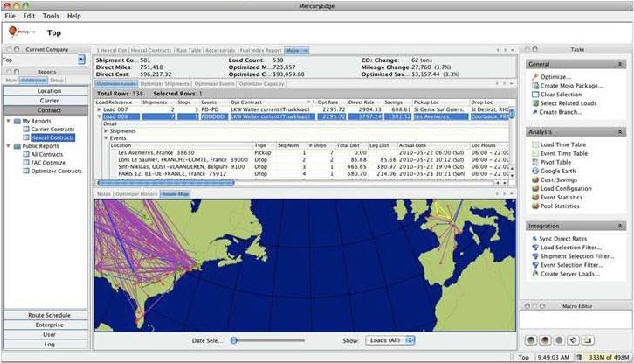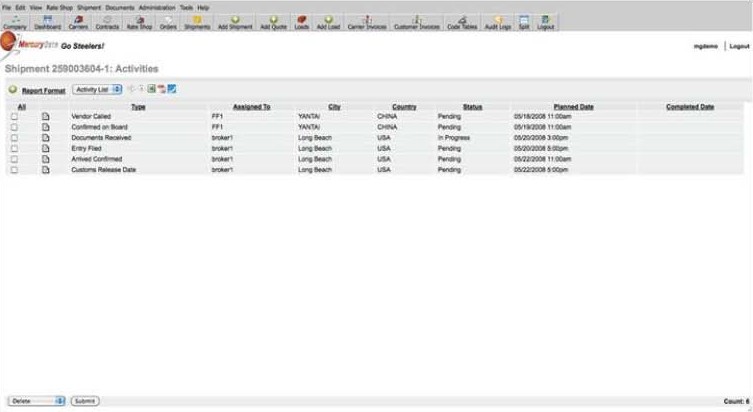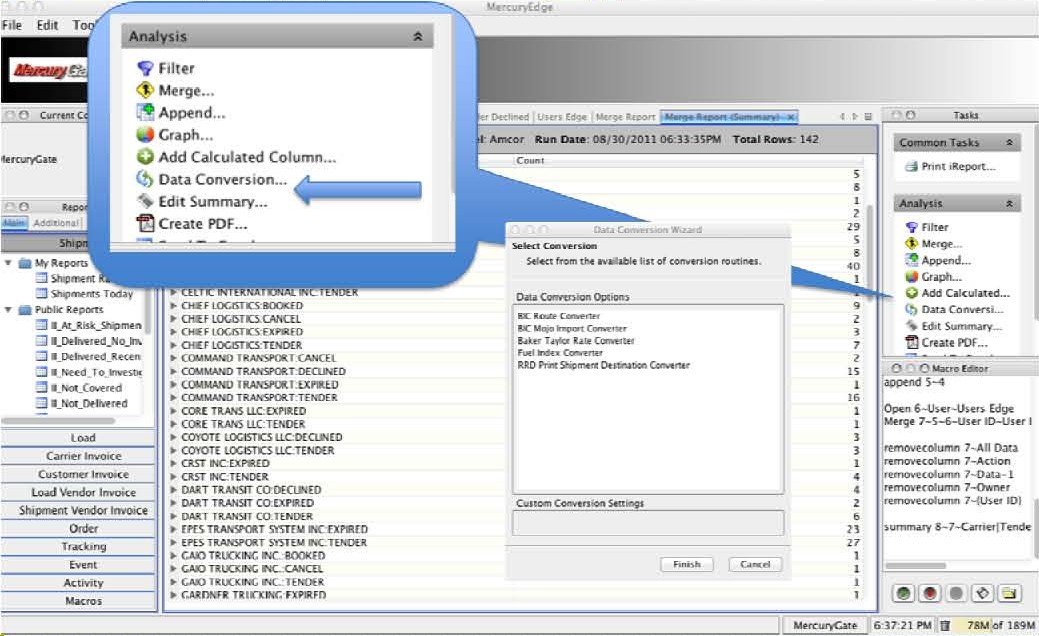MercuryGate Benefits Logistics Service Providers
Cary, North Carolina USA Site Visit
January 18, 2012
By
Evan Armstrong
Key Personnel:
Monica Wooden, CEO
Steve Blough, President
MercuryGate Overview
Founded in 2000, Cary, North Carolina based Transportation Management Systems (TMS) developer MercuryGate International has built a sizable business. With a staff of 75, it generated revenue of just over $17 million in 2011. More impressive, however, is how MercuryGate’s web-native TMS solutions have generated significant market demand. Its customer base now totals over 130 third-party logistics providers (3PLs) and freight brokers and 50 shippers. In 2010 and 2011 alone, MercuryGate added 82 new customers. It is planning to add an additional 48 customers in 2012 pushing revenues to approximately $22 million.
From our ongoing survey work of 3PLs and freight brokers, we have identified three key factors which have driven MercuryGate’s rapid growth: 1. The breadth of its offering, allowing logistics providers to use the single MercuryGate application for all transportation planning and execution functions, 2. As a web-native hosted solution with interfaces to multiple enterprise resource planning and warehouse management systems it can be deployed rapidly, and 3. Its flexible pricing model allows startups to affordably use the software and larger organizations to reduce the risk of a large up-front investment. MercuryGate’s key 3PL accounts include: A&R Global Logistics, BNSF Logistics, GENCO, Kenco, MIQ Logistics, Mode Transportation, OHL, Ryder, and Transportation Insight. Additionally, it counts Baker & Taylor, Cargill, Celestica, HD Supply, Jabil, McLane, R.R. Donnelley, Raytheon, and Siemens as key shipper accounts.
Key TMS Functionality
We have seen MercuryGate’s TMS in use at several operations and were provided with additional system demonstrations from its current TMS release. MercuryGate has built the following functionality into its TMS which has significant advantages for 3PLs and freight brokers:
- Buy (carrier) and sell (shipper) side system functionality is inherent to the software.
- The system architecture uses a hierarchical company and account structure which allows inheritance as well as modeling of appropriate levels of access and reporting for complex configurations.
- The TMS has the ability to allocate transportation costs from consolidated shipments and truckloads back to individual shippers/3PL customers.
- The “Carma” carrier management module provides for CSA compliance management and interfaces to Registry Monitoring Insurance Services (RMIS), Transcore and Carrier 411 for carrier insurance and operating authority information.
- Carrier service performance tracking and reporting are standard.
- Easy to use “Mojo” order to shipment mode conversion/optimization provides users with the ability to consolidate and optimize orders and shipments between multiple modes including intermodal rail and small package/parcel.
- Mojo uses actual rated shipment costs, handling, accessorial charges, and surcharges for optimization versus benchmark costs.
- Mojo and “MercuryEdge” can be used separately for transportation modeling to support customer request for proposal bid work.
- Expanding international transportation management functionality including multi-leg shipment optimization and routing.
- The TMS provides users with historical carrier rate lookups by lane and other user defined parameters.
- It supports individual freight broker load posting boards.
- MercuryGate integrates with Transcore, Internet Truckstop, MercuryGate’s “FreightFriend”, and other websites to search for carrier capacity and to post available loads.
- The TMS has easy to use interfaces and functionality for performing customer rate quotes.
- Well detailed alerts and filters for key shipment service performance and back office processing milestones are incorporated.
- Significant reporting capabilities for overall, customer, lane, and carrier profitability analysis are included.
- It has a known software upgrade path via its hosted environment which releases new versions of its TMS every eight weeks.
- MercuryGate’s TMS workflows and screens are easily customizable allowing 3PLs to rebrand the TMS as their “own” software.
- The core TMS supports 12 different languages.
Mojo Transportation Optimizer
Traditionally many 3PLs developed proprietary TMS to manage their transportation operations (day-to-day transportation execution) and would often integrate their systems with a commercial software vendor’s transportation planning system such as JDA/i2 or Oracle to add transportation mode and route optimization functionality. By comparison, MercuryGate’s Mojo optimizer was developed in house and resides in its MercuryEdge tool.
Mojo is a many-to-many transportation network optimizer which means it can consolidate inbound and outbound orders into larger shipments and route them via the best transportation mode across multiple shipper and consignee locations, cross docks, and lanes. It determines the best carrier and mode routings using actual calculated rates and provides users with the ability to develop optimization strategies based upon multiple parameters including:
- Multiple transportation modes including parcel
- Air, ocean, and rail schedules
- Maximum out of route miles and cluster strategies
- Reverse stop constraints
- Continuous move stop-in-transit restrictions
- Equipment constraints and driver hours of service limits
- Pick-up and delivery windows
- Hours of operation limits
- Dock schedules and availability
- Vehicle capacity and transit times
- Average ground speed
- Time to service stops
- Vehicle loading methods
- Pool point hold times
- Fuel surcharge attributes
Mojo can simultaneously optimize inbound and outbound loads and optimize transportation equipment based upon positioning schedules. It can create and archive multiple alternative transportation plans using different parameters prior to being executed. Mojo also has built in functionality to calculate the carbon footprint and emissions reductions using Mojo’s CO2 calculator. Another differentiating feature of Mojo is its ability to communicate to a transportation planner why certain shipments were not part of an optimization plan.
Mojo is accessed as a Java Swing thicker-client application versus a pure internet browser application. According to MercuryGate, this configuration increases its functionality and speeds up its processing time. In our demo, we saw Mojo optimize 221,000 load possibilities in 11.48 seconds.
MercuryGate Mojo Optimizer Screenshot

International Transportation Management
Like most U.S. based TMS developers, MercuryGate was initially focused on meeting the needs of the domestic transportation management market. Over the past five years, however, MercuryGate has invested substantially in rounding out its international transportation management capabilities which are becoming a key competitive differentiator. Swiss based freight forwarder NV Logistics and Singapore based distributor Zuellig Pharma are using MercuryGate for international transportation management. Armstrong & Associates has specifically consulted with two companies, having international transportation management requirements, that selected MercuryGate to support their operations. Each has provided us with positive feedback on their experiences with MercuryGate’s TMS. In addition, the application supports inland transportation, airfreight, and ocean shipping.
MercuryGate’s international transportation management functionally includes:
- The creation and management of multi-leg and multi-modal export and import shipments
- Supports electronic filing of U.S. government mandated documents and 10+2 importer security filing for cargo customs clearance
- Determination of complex taxes (taxes based on distance driven in country, VAT taxes, etc.)
- Localization allowing end users to define screen layouts and transportation terms
- Full landed cost calculation
- Optimization of multi-geography orders with multiple modes
- Creation of international shipping documents such as pro-forma invoice, commercial invoice, dock receipt, certificate of origin, etc.
For full container load (FCL) and less-than-container load (LCL) ocean shipments, MercuryGate breaks each route/movement into its individual events and transportation legs for optimization and shipment planning. The process starts with the shipment and the container (multiple container moves can also be accommodated). The TMS handles a shipment as a request to move the container from an origin point to a destination point. Several transportation legs/movements are often required to complete a shipment. The TMS can support door to door, port to port, port to door, railhead to door, port to railhead, and additional multi-leg and mode routings. All of the costs for each leg are summarized on the shipment and are aggregated for calculation of the total landed cost of each move. The TMS provides for landed costs to be determined in any currency as needed for proper accounting. In addition, MercuryGate has built in electronic shipment status updates, required milestones, and mapping tools for visibility throughout the lifecycle of each move.
MercuryGate International Transportation Management Ocean Shipment Activity Screenshot

Reporting and Embedded Analytics
The TMS also has some appealing online business intelligence and reporting tools. For example, the TMS chart below shows the number of shipments that a freight forwarder shipped and delivered in one day for multiple countries.
MercuryGate Customer Daily Shipments Shipped and Delivered Activity Reporting

MercuryGate has also started including what is typically thought of as after the fact business intelligence into the day to day operations. For instance, the screen shot below shows how target rates are visible during a rate shop.
Example of Embedded Analytics Showing Lane Goals along with Carrier Cost

The MercuryEdge tool provides sophisticated reporting capabilities that can be used outside the TMS, but which also has access to all the reports, data, and rates contained within the TMS, helping to mitigate the need for external reporting tools.
Sophisticated Reporting Capabilities of MercuryEdge

As with all TMS providers, the operational and productivity improvements they provide to customers are key. Therefore, we have included two customer case studies below to detail how MercuryGate has supported two of its 3PL customers.
MercuryGate Customer Case Studies
MIQ Logistics
Headquartered in Overland Park, Kansas, 3PL MIQ Logistics (previously YRC Logistics) provides domestic and international transportation management and value-added warehousing and distribution services to customers in North America, Latin America, Europe, and Asia. Along with its global network partners, MIQ provides services in and between more than 80 countries.
Prior to migrating to MercuryGate’s TMS, MIQ Logistics had developed its own proprietary TMS dubbed “PowerTMS”. PowerTMS was initially developed as a rate quotation and shipment management system and was later expanded to include additional modes and operational disciplines.
As MIQ grew its business, additional customer requirements were incorporated into the PowerTMS system. In addition, components were added from commercial software vendors to fill other functional needs. In 2009, MIQ faced the need to “make or buy” several major component subsystems to extend its 3PL solutions portfolio. The key issue for MIQ was how to most efficiently allocate its capital. The capital requirements within other lines of business caused MIQ to critically evaluate replacing PowerTMS with an integrated commercial TMS offering.
MIQ had three key criteria for evaluating commercial TMS software. First, the software must be functionally complete with the ability to manage shipment planning, day-to-day execution, freight payment, and provide complete visibility to in-transit shipments. Further, these capabilities had to extend to all carriers and modes — truck, rail, ocean, air, and parcel. Second, the system must support freight broker operations and manage MIQ’s relationships with multiple shippers and carriers (including the freight billing/payment and revenue accounting). Third, the system had to be web-native in order to be consistent with and integrate with all other MIQ systems. It had to support over 100 MIQ personnel both in a central transportation management center and at onsite customer operations, with the ability to scale beyond current operations.
After conducting a competitive evaluation of several vendor’s systems, MercuryGate was selected. MercuryGate’s TMS fulfilled all of the key selection criteria and in addition, MIQ perceived MercuryGate as a “like-minded” company of the same size, age, and culture. MIQ believed that MercuryGate shared its customer service-orientation and would work closely with it to make the transition as easy and effective as possible.
The key implementation issue became the conversion of MIQ’s existing account base. MIQ had built complex integrations with many customers systems. In addition, MIQ had developed customized reports for many customers which had to be replicated in the MercuryGate TMS. In the 18 months since the beginning of the conversion, over 50% of the MIQ customer base have been migrated to the MercuryGate TMS and MIQ will be converting the balance of its customer base to the MercuryGate TMS in the coming months.
While MIQ wishes to keep specific financial savings from switching to MercuryGate private, it states that its return on investment (ROI) calculation made the decision to buy versus continue to build its own TMS relatively obvious. Its ROI calculation included the cost of conversion as well as the cost of software acquisition and long-term support. Key categories of savings included avoiding significant development and system maintenance expenses, and reducing operational expenses and personnel.
Xpress Network Solutions
U. S. Xpress, Inc. started Xpress Network Solutions (XNS) in 2007 to build a freight brokerage and 3PL business to complement its existing transportation services offering. The initial plan included specialized operations growing over time into a market leading 3PL. The planned timeline changed with a 3PL opportunity that was met with a very short implementation time.
XNS’s first customer was a large shipper with a $30 million transportation spend across multiple modes (truckload, less-than-truckload, small package, tanker, and international) which had to be implemented in 45 days. It had 8,000 loads per month across five divisions. The company’s information technology requirements were extensive and included 21 external system connections including EDI, industry specific XML, freight bill payment with EDI invoicing, and multiple web portals. Using MercuryGate’s TMS, XNS was able to quickly onboard this customer within the 45-day timeline. The operation originally had a staff of 12 which through process automation has been reduced to seven significantly reducing operational costs.
XNS’s second customer had a $15 million transportation spend with truckload and less-than-truckload carriers. It did not have as many connection types as XNS’s first customer, but had its own challenges. According to XNS, the challenges were all met by the XNS and MercuryGate team and were highlighted by a successful integration with SAP using MercuryGate’s standard IDOC interface. Using MercuryGate’s TMS, the 3PL has realized cost savings for its customer of over 25%.
XNS uses MercuryGate as the primary freight brokerage/3PL TMS. Its freight brokerage operation has expanded to over $18 million in revenue and is growing profitably.
MercuryGate Summary
MercuryGate’s broad TMS functionality, easily deployable solutions set, and flexible pricing model are driving its growth. It has been able to go head-to-head with larger TMS competitors JDA and Oracle and become the selected TMS provider. With MercuryGate’s advances in TMS functionality and commitment to a web-native model with an ongoing upgrade path, we anticipate that it will continue to grow and meet the needs of many 3PLs, freight brokers, and shippers.


